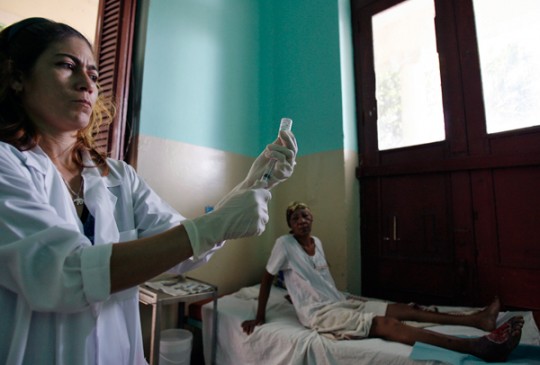Health insurance no guarantee for diabetes care in developing countries, Stanford researchers find
Health insurance no guarantee for diabetes care in developing countries, Stanford researchers find
Without good health care, diabetics run the risk of developing more problems, such as blindness, heart disease and kidney failure. Stanford researchers warn that those complications will put a greater financial strain on the patients and the developing countries where they live – a problem that can be addressed with improvements to health care and insurance systems.
 A doctor prepares an injection for a diabetes patient in a Cuban hospital. Diabetes is on the rise in Latin America and throughout many developing countries, but access to care and medication for the disease is often costly and scarce, according to Stanford researchers.
A doctor prepares an injection for a diabetes patient in a Cuban hospital. Diabetes is on the rise in Latin America and throughout many developing countries, but access to care and medication for the disease is often costly and scarce, according to Stanford researchers.
As incomes rise around the world, health experts expect a more troubling figure to increase as well: the number of diabetics in developing countries.
In China and India – two of the world’s most populous nations, both with fast-paced economies – the prevalence of diabetes is expected to double by 2025. Between 15 and 20 percent of the adult populations will develop the disease as household budgets increase, diets change to include more calories and new health problems emerge.
But China, India and other developing countries are not fully prepared to deal with the rising trend of diabetes. And a growing number of diabetics aren’t getting the care they need to prevent serious complications, Stanford researchers say.
Even with insurance, many diabetics don’t have essential medications that could help them manage their conditions. In many cases, people in developing countries are spending a great deal of their household incomes to pay for their treatment, said Jeremy Goldhaber-Fiebert, an assistant professor at the Stanford School of Medicine who led the research team.
Insurance programs fail to protect
“Public and private health insurance programs aren’t providing sufficient protection for diabetics in many developing countries,” said Goldhaber-Fiebert, a faculty member at Stanford Health Policy at the university’s Freeman Spogli Institute for International Studies. “People with insurance aren’t doing markedly better than those who don’t have it. Health insurance and health systems need to be re-oriented to better address chronic diseases like diabetes.”
Findings from the study are online and will be published in the Jan. 24 edition of Diabetes Care, the journal of the American Diabetes Association. The journal article was co-authored by Jay Bhattacharya, an associate professor of medicine and Stanford Health Policy faculty member, and Crystal Smith-Spangler, an instructor at Stanford’s Department of Medicine and an investigator at the VA Palo Alto Health Care System.
Failure to adequately manage diabetes will lead to more severe health problems like blindness, heart disease and kidney failure.
Diabetes often strikes people at an age when they’re taking care of children and elderly parents. To sideline these primary caretakers as dependants will lead to a heavy burden for communities and create an obstacle for economic growth, Goldhaber-Fiebert added.
Using responses to a global survey conducted by the World Health Organization in 2002 and 2003, Goldhaber-Fiebert and his colleagues examined data from 35 low- and middle-income countries in Asia, Latin America, Africa and Eastern Europe to determine whether diabetics with insurance were more likely to have medication than those without insurance.
They also wanted to know whether insured diabetics have a lower risk of “catastrophic medical spending,” a term the researchers define as spending more than 25 percent of household income on medical care.
“Surprisingly, diabetics with insurance were no more likely to have the medications they need than uninsured diabetics,” Goldhaber-Fiebert said. “They were also no less likely to suffer catastrophic medical spending.”
Shortage of medicines
There are many reasons why health insurance may not protect diabetics in developing countries against high out-of-pocket spending. In some cases, there’s a lack of sufficient medicine – such as insulin – to regulate glucose levels. Without those drugs, there is a greater risk of complications that often lead to more hospitalizations and more expenses.
In other cases, co-payments and deductibles are too high. Sometimes, drugs and medical services useful in preventing diabetes complications are not covered. And doctors and hospitals don’t always accept insurance.
“Better policies are needed to provide sufficient protection and care for diabetics in the developing world,” Goldhaber-Fiebert said.
Without medications to manage diabetes and prevent secondary complications, the condition will worsen and the burden of catastrophic spending will increase, he said.
“It’s important to get ahead of the curve and prepare so there’s an infrastructure in place to deal with these health and cost issues,” he said.
While preventing diabetes in the first place would be ideal, programs and policies must be established to care for the many cases that will surely continue to exist.
“There isn’t a single country that’s managed to entirely arrest or reverse the trend of diabetes,” he said. “Programs that focus on primary prevention are extremely important, but the reality is that the developing world faces hundreds of millions of diabetes cases that are unlikely to all be prevented.”
By Adam Gorlick
Adam Gorlick is the communications manager for the Freeman Spogli Institute for International Studies.
###
* Stanford University Medical Center integrates research, medical education and patient care at its three institutions – Stanford University School of Medicine, Stanford Hospital & Clinics and Lucile Packard Children’s Hospital.
** The above story is adapted from materials provided by Stanford University School of Medicine
________________________________________________________________



















